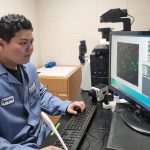Working to Detect Ovarian Cancer Earlier

About 15 years ago, researchers were surprised to discover that one of the most common and lethal forms of ovarian cancer originates, not in the ovaries, but as miniscule precursor lesions on the fallopian tubes. This finding has now begun to change the way scientists and doctors research, treat, and diagnose this often-deadly form of cancer.
Even so, there are still no early screening tests for ovarian cancer, and most cases aren’t diagnosed until late stages, leaving less time for treatment and therapies to stop the cancer from spreading.
Tom Pisanic, associate research professor at the Whiting School of Engineering’s Institute for NanoBioTechnology and Johns Hopkins School of Medicine’s Department of Oncology, is co-leading a team working to change that. Their goal is to develop a device that can identify ovarian cancer cells from routinely collected Pap specimens: an approach they hope could become a part of routine cancer screenings, just like modern tests for prostate, breast, and cervical cancers.
“Genetic tracing studies have shown that it takes on average about six to seven years from when the lesion begins in the fallopian tube to progress to ovarian cancer,” Pisanic said, “so there’s a key window of time that we may be able to detect and prevent the cancer altogether.”
More than 20,000 women in the United States are diagnosed with ovarian cancer each year, according to the American Cancer Society. Pisanic’s approach to the development of noninvasive and cost-effective strategies for early detection of cancer involves epigenetics, which are processes and chemical alterations that can lead to profound impacts on gene expression and cell behavior. Epigenetics alter how your body reads and responds to a DNA sequence without changing the DNA sequence itself. The most studied epigenetic alteration is DNA methylation, which is a chemical alteration of DNA often associated with gene silencing or turning genes “off.”
In their studies, Pisanic and his team analyze DNA from miniscule samples of fallopian tube tissue, searching the genome to locate the specific regions that are normally unmethylated in healthy cells, but later become methylated in cancer cells. The idea is that sensitive, noninvasive tests could be developed to detect these changes in methylation at early, precursor stages of ovarian cancer, so that the disease can be intercepted before spreading to the ovary, when treatment becomes much more difficult.
This can be very challenging, Pisanic said, because it requires exploring hundreds of thousands of regions in the genome to find the changes in DNA methylation that can serve as effective biomarkers to detect cancer at its earliest stages.
“Once we have identified methylation biomarkers, the bigger problem becomes developing and testing methods to reliably detect these alterations, which are generally very rare in noninvasively collected samples, such as Pap specimens or blood,” he said.
While ovarian cancer is challenging to both detect and treat, there are preventative steps that women can take now to help assess their risk of developing the disease, he says. In addition to regular checkups–especially if excessive bloating, pelvic pain or abnormal bleeding are present–women should also consider genetic testing for mutations in the BRCA genes, as women with mutations in these genes are up to 50 times more likely to develop ovarian cancer in their lifetime, he says. Women can ask their primary care provider or gynecologist about these tests, which are safe, effective, and can oftentimes be performed using a simple cheek swab.
Part of Pisanic’s efforts against cancer involve his participation in the Break Through Cancer foundation, an alliance of five of the world’s leading cancer research centers dedicated to supporting research in the most difficult-to-treat cancers. Pisanic was recently appointed as a “Break Through Cancer Scientist” to actively work with the foundation to engage and stimulate collaboration between investigators at the research centers with the goal to improve the way cancer is detected, treated, and cured.
For example, in one project, Pisanic is working together with other Break Through Cancer members to develop new analysis methods that will allow surgeons to use imaging to rapidly scan a patient’s fallopian tubes to identify the precursor lesions that can lead to ovarian cancer.
“Our solutions bring together engineers, scientists and clinicians to tackle these problems from different angles,” Pisanic said. “They bring people that are experts in all the necessary fields to come up with the best solution.”





